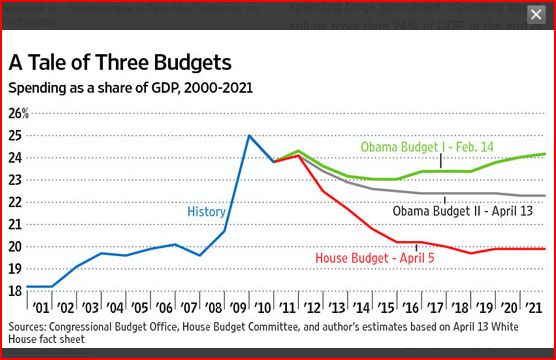John Taylor’s op-ed in today’s Wall Street Journal bashes the White House budget proposals of February 14 and April 13 and lauds the House Republican budget proposal of April 5.
I understand–or am coming to understand–that when writing for a non-specialist audience, a certain amount of simplification is necessary: I’m guessing that the Journal has never actually published the regression results backing up the op-eds published in its pages. I get it. Really, I do.
But Taylor’s simplifications go so far as to be misleading.
First, he laments the fact that the budget increased from 18.2% of GDP in 2000 to 19.6% of GDP in 2007, and has since risen to about 24.4% of GDP. The implication of this statement is that while Taylor’s boss, George W. Bush, was president (Taylor was Under Secretary of the Treasury for International Affairs during the Bush Administration), spending was under control. This implication omits several inconvenient facts.
- The substantial increase in the government’s budget after 2007 resulted, in large part, from responding to the most substantial financial crisis and recession since the Great Depression.
- Had government spending not increased dramatically, the Great Recession would have morphed into a rerun of the Great Depression.
- The financial crisis itself was partially the result of the irresponsible fiscal policies (fighting two wars and cutting taxes at the same time) of that same Bush Administration.
According to Taylor: “A simple chart, like the one nearby, would greatly clarify the debate.” He later writes: “ When I show people this chart they ask why Washington is even having the debate.”
When I show people this chart they ask why Washington is even having the debate.”
Probably because the chart glosses over several important issues. The House Republican budget, as the Economist notes, uses excessively optimistic forecasts. Additionally, the Republican budget proposal shifts some of the costs of Medicaid onto the states, by replacing the current system with a set of block grants that will reduce federal spending. This may or may not be a good idea, but the net effect is merely to reduce federal spending at the expense of the states.
To simplify: reducing the federal budget deficit by an amount and increasing the aggregate of all state budget deficits by the same amount does not demonstrate fiscal rectitude.
To claim, as Taylor does that, “…the House budget plan, with spending in the same range, approximately balances the budget with no increase in taxes…” is misleading. John Taylor should know better.




I’m with you until:
“The financial crisis itself was partially the result of the irresponsible fiscal policies (fighting two wars and cutting taxes at the same time) of that same Bush Administration.”
I think this is 180 degrees off. The situation that led to the crisis came about because a lot of people wanted to buy safe assets and there weren’t enough genuinely safe assets available, so Wall Street sought to fulfill the demand by creating a lot of ostensibly safe assets, which turned out not to be safe at all. The genuinely safe assets that were available were issued by the US Treasury specifically as a result of the Bush fiscal policy. Those assets were able to satisfy a significant fraction, although not enough, of the demand for safe assets. If those assets hadn’t been available, if the Bush administration (and Congress) hadn’t chosen to cut taxes and fight two wars, the demand for fake safe assets would have been much larger, and presumably the crisis, when those assets turned out not to be safe, would have been much more severe.